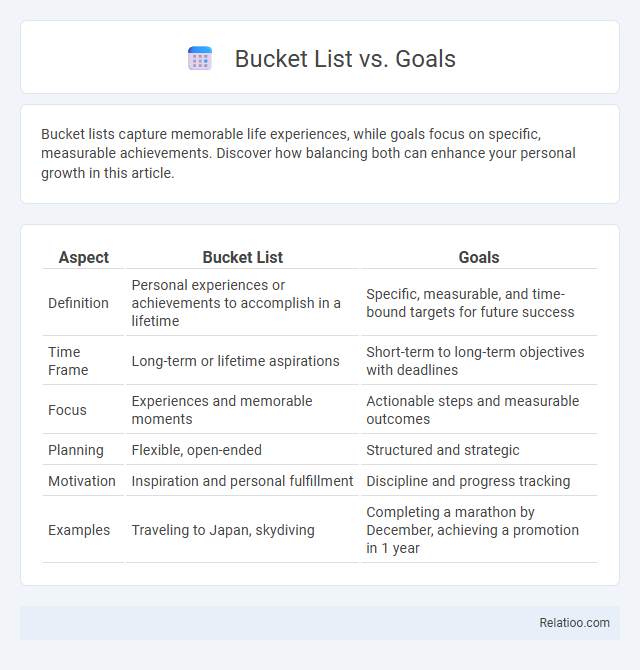Bucket lists capture memorable life experiences, while goals focus on specific, measurable achievements. Discover how balancing both can enhance your personal growth in this article.
Table of Comparison
| Aspect | Bucket List | Goals |
|---|---|---|
| Definition | Personal experiences or achievements to accomplish in a lifetime | Specific, measurable, and time-bound targets for future success |
| Time Frame | Long-term or lifetime aspirations | Short-term to long-term objectives with deadlines |
| Focus | Experiences and memorable moments | Actionable steps and measurable outcomes |
| Planning | Flexible, open-ended | Structured and strategic |
| Motivation | Inspiration and personal fulfillment | Discipline and progress tracking |
| Examples | Traveling to Japan, skydiving | Completing a marathon by December, achieving a promotion in 1 year |
Defining Bucket Lists and Goals
Bucket lists represent a collection of experiences or achievements you aspire to complete in your lifetime, often focused on personal fulfillment or adventure. Goals are specific, measurable targets designed to guide your progress in various aspects of life, such as career, health, or education. Understanding the distinction between bucket lists and goals helps you prioritize immediate passions versus structured milestones for long-term growth.
Key Differences Between Bucket Lists and Goals
Bucket lists consist of experiences or achievements you wish to accomplish in your lifetime, often emphasizing adventure or personal fulfillment, while goals are specific, measurable objectives set to achieve progress within a defined timeframe. Unlike goals, bucket lists are typically broad and aspirational, lacking strict deadlines or detailed action plans. Understanding the key differences helps you prioritize actionable steps for goals and inspire motivation through meaningful bucket list items.
Purpose and Motivation Behind Each
Goals are specific, measurable targets set to guide your progress and achieve tangible results, often driven by deadlines and clear success criteria. A bucket list captures life experiences and aspirations you wish to fulfill, motivated by a desire for personal adventure and meaningful memories before a certain time, typically life's end. While goals focus on structured achievement and progress, your bucket list is fueled by passion and the purpose of living fully and embracing unique life moments.
Short-Term Goals vs. Lifelong Aspirations
Short-term goals typically consist of specific, achievable tasks designed to be completed within a limited timeframe, helping individuals build momentum and track progress. Lifelong aspirations encompass broader, meaningful ambitions that guide personal growth and fulfillment over an extended period, often inspiring long-term planning. Bucket lists combine elements of both, capturing desired experiences and achievements to pursue throughout life, blending immediate objectives with enduring dreams.
How to Create an Effective Bucket List
Creating an effective bucket list involves identifying meaningful experiences and aspirations that align with Your passions and values, prioritizing them based on personal significance and feasibility. Break down each item into actionable steps with specific timelines, ensuring measurable progress toward fulfillment. Incorporate flexibility to adapt goals as Your interests evolve, making the bucket list a dynamic tool for lifelong motivation and achievement.
Setting SMART Goals for Success
Setting SMART goals enhances your ability to transform a vague bucket list into actionable achievements by making objectives Specific, Measurable, Achievable, Relevant, and Time-bound. Unlike a general bucket list that highlights dreams and experiences, SMART goals prioritize clarity and accountability, increasing the likelihood of success. Your commitment to defining these precise goals can lead to meaningful progress and fulfillment beyond mere wishful thinking.
Integrating Bucket List Items into Your Goals
Integrating bucket list items into your goals transforms aspirational dreams into actionable plans by setting measurable milestones and deadlines. This approach enhances motivation and ensures consistent progress toward fulfilling significant life experiences while maintaining alignment with personal growth objectives. Effective integration requires prioritizing items based on impact and feasibility, allowing for a balanced pursuit of both immediate achievements and long-term aspirations.
Common Mistakes to Avoid
Confusing bucket lists with goals often leads to unrealistic expectations, as bucket lists represent aspirational experiences while goals are specific, measurable, and time-bound objectives. Neglecting to prioritize or break down goals can result in overwhelm and decreased motivation, whereas treating bucket lists as urgent must-complete tasks may cause stress and disappointment. Avoid the mistake of mixing short-term actionable goals with long-term dreams, ensuring clear differentiation to maintain focus and achieve meaningful progress.
Benefits of Balancing Both Approaches
Balancing bucket lists and goals enhances personal growth by combining spontaneous adventure with structured achievement, maximizing life satisfaction and motivation. Bucket lists fuel inspiration through unique experiences, while goals provide measurable progress and long-term focus, creating a dynamic approach to self-improvement. Integrating both ensures a well-rounded, fulfilling journey that nurtures creativity and discipline simultaneously.
Choosing What’s Right for You
Choosing between a bucket list, goals, and a mission statement involves understanding their distinct purposes and how they align with your personal values and aspirations. A bucket list captures experiences you wish to achieve, goals are specific, measurable targets driving progress, and a mission statement defines your overarching life purpose. Prioritizing what resonates with your current mindset and long-term vision ensures that the chosen approach effectively motivates and guides your actions.

Infographic: Bucket List vs Goals
 relatioo.com
relatioo.com